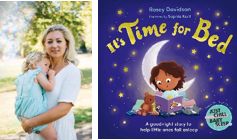
More than a quarter of parents don’t feel equipped to have that first ‘money conversation’ with their children – because they don’t feel confident with their own finances or find it hard to explain in a way their children will understand.
A study of 2,000 adults with children aged up to 17 found 97 per cent thought it was important to teach their kids about money, but are unsure how – and when – they should start to introduce it.
The average age that parents feel able to introduce the subject of money with their children is five years old.
However, the study by M&S Bank found 38 per cent said they didn’t know what age their child should be when they approach the concept of money.
And only a third (34 per cent) had spoken to their child about money before they turned five years old.
The research found three in 10 (29 per cent) are hesitant to talk about money with their kids because they don’t feel they’d be a good teacher.
While 28 per cent find it difficult to simplify the topic, and don’t feel like they are very good with money themselves (28 per cent).
And more than a third (35 per cent) struggle to explain things in a way their child would understand.
Psychologist Emma Kenny said: “It’s important that as parents, we take the time to talk confidently and openly with our children about money, and from an early age.
“The M&S Bank research found that the most common age to start introducing money into conversations is from age five.
“But parents can do this through play even earlier, which can really help to give meaning to your conversations, whenever the time is right for you.
“Early conversations can really help your children to not only understand the concept and value of money, but also help to set a positive and confident financial foundation, that will benefit them in later life.”
The study also revealed the tactics parents are using to help them teach their little ones about finances, with a quarter (25 per cent) ‘playing shop’ with their child from the age of three.
A fifth (19 per cent) found introducing pocket money a useful lesson from the age of five, and 22 per cent used counting money, also from the age of five.
The research also found nearly half (44 per cent) believe taking their child to the shops specifically to help them learn how money works is an effective teaching method.
But while 80 per cent of parents said they have discussed money with their children in some capacity, 60 per cent felt they should be doing more to help their little ones learn, and from an earlier age.
Among the reasons parents feel it’s important to talk about money included ‘it prepares them for the future’ (75 per cent), ‘it’s a part of life’ (70 per cent) and ‘it helps them understand savings’ (62 per cent).
It also emerged some of the biggest worries parents have for their youngster’s financial future is whether they will be able to support themselves financially (55 per cent), if they will be able to build their own savings (46 per cent) and if they will be confident with money (35 per cent).
With the world moving towards a more cashless society, 35 per cent of parents were also concerned about helping their child understand the value of money in a world of digital payments.
And more than a third (36 per cent) of parents would like additional support on how to speak to their children about money and finances, particularly when it comes to answering tough questions.
Nearly a quarter (23 per cent) of children typically ask more than three money-related questions a week, including ‘Is £1 a lot of money?’ and ‘Why do we need money?’.
Gill Roberts, head of products, M&S Bank, said: “It is great to see that many parents are having conversations about money with their children.
“But it’s also interesting that many parents still feel they could be doing more to help their children learn about money; and many felt they would benefit from further support themselves.
“Our research highlighted that over a quarter of parents said they would welcome a rhyme or poem that they could sit and learn together with their child.
“So we partnered with renowned children’s poet Roger McGough to create something new to support the introduction of those early conversations about money.”
The research lands during M&S’s Little Shop 2 campaign, which this year includes a new collectable – the M&S Bank piggy bank, which is a great way to start introducing those first conversations around money.
TOP 10 TRICKIEST QUESTIONS TO ANSWER ABOUT MONEY ACCORDING TO PARENTS:
1. Where does money come from?
2. Why do some people have lots of money?
3. ‘How can I get rich?’
4. ‘Why do we need money?’
5. ‘How can I make money?’
6. ‘Is £1 a lot of money?’
7. ‘What can I buy with 50p?’
8. ‘How much is a house?’
9. ‘Can I have some money?’
10. ‘Are we rich?’
TIPS FOR TALKING MONEY MATTERS WITH CHILDREN – EMMA KENNY
1) INTRODUCE YOUR CHILD TO THE CONCEPT OF MONEY AS EARLY AS POSSIBLE
Whether it’s through play or simple observations in and outside of the home – try to look for opportunities to introduce your child to the concept of money.
This could be as simple as giving your child their own mini budget to buy something when you do your weekly shop – whether that’s a snack or a treat like a colouring book or crayons, enabling them to make choices within their budget.
These early conversations are important as they can help your children to understand the concept and value of money, but also help to set a positive and confident financial foundation, which could help them later in life.
2) HELP YOUR CHILD APPRECIATE THE VALUE OF SETTING AND REACHING SMALL GOALS
Whether you give your child a little pocket money for good behaviour – or for doing small chores around the house, such as keeping their room tidy – earning a small reward helps to bring a sense of satisfaction when they finally reach that all important goal.
Psychological studies have shown that delayed gratification is important for children to experience as in the short-term it encourages self-control and patience.
While in the long-term, it can help contribute to academic success, social responsibility and a greater capacity for dealing with stress and frustration.
3) TRY USING THE THREE ‘W’S’
When your child asks for a particular item, a practical tool you could use to help them think more about how they are spending their money is the three W’s:
What is it they want?
What is it for?
Why do they need it?
By using this approach and encouraging your child to answer these questions for themselves, you are encouraging them to consider their choices.
This is a life lesson that your child can carry with them as they get older and it will help them develop a sense of gratitude for the items they do receive.
4) MAKE LEARNING FUN THROUGH PLAY
Interactive activities, such as counting money, playing shop or reading a poem or rhyme, are tried and tested methods of helping children to better understand the concept of money.
The benefits of bringing learning to life through interactive play are multi-fold and include children becoming better problem solvers – with an increased ability for critical thinking – nurturing creativity and imagination, and building skills such as compromise, conflict resolution and sharing.
When it comes to playing shop, to help children learn and engage you could try adding price tags to different priced items, such as toys, alongside everyday items, such as fruit and vegetables, as this will help your child see the value of different items alongside each other.
5) SHOW HOW MONEY CAN BE BUDGETED AND SPENT IN DIFFERENT WAYS
To help your child understand that the family budget accounts for more than just the physical items they can see – such as the weekly food shop – you could share practical examples of your family budget, that are easy to understand, and that your children can get involved with.
This could be something as simple as allocating a small amount each month to a family day out or activity and then involving your children in deciding on what the day out should be – you could explain that if they go for a picnic one month, next month they could all go to the zoo.
Not only does this help your child understand the different ways the family budget is spent, it gives them a sense of excitement and responsibility.
6) HELP THEM UNDERSTAND DIFFERENT WAYS TO PAY, SUCH AS DIGITAL AND CONTACTLESS
One of the challenges parents said they have when teaching their child about money was helping them understand the value of money in the context of digital payments.
To help overcome this, when you next talk to your child about money – or play shop- you could try using a range of different payments – including cashless payments such as contactless and card transactions – so it becomes familiar territory.
When you are shopping online, you could also show them how digital payments work.
ENDS





















